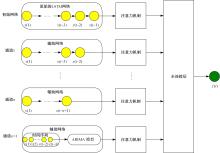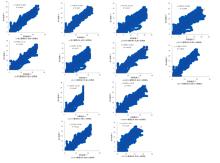Journal of Jilin University(Engineering and Technology Edition) ›› 2023, Vol. 53 ›› Issue (10): 2973-2981.doi: 10.13229/j.cnki.jdxbgxb.20211386
Previous Articles Next Articles
Integrated LSTM and ARIMA method based on attention model for soil temperature
Qing-tian GENG1( ),Yang ZHAO1,Qing-liang LI1(
),Yang ZHAO1,Qing-liang LI1( ),Fan-hua YU2,Xiao-ning LI1
),Fan-hua YU2,Xiao-ning LI1
- 1.College of Computer Science and Technology,Changchun Normal University,Changchun 130032,China
2.College of Computer Science and Technology,Beihua University,Jilin 132013,China
CLC Number:
- TP391
| 1 | Lai L M, Zhao X C, Jiang L H, et al., Soil respiration in different agricultural and natural ecosystems in an arid region[J]. PLoS One, 2012, 7(10): 1-9. |
| 2 | Kisi O, Sanikhani H. Modelling long-term monthly temperatures by several data-driven methods using geographical inputs[J]. International Journal of Climatology, 2015, 35(13): 3834-3846. |
| 3 | Bonakdari H, Moeeni H, Ebtehaj I, et al. New insights into soil temperature time series modeling: linear or nonlinear?[J]. Theoretical & Applied Climatology, 2019, 135(3/4): 1157-1177. |
| 4 | Zhang J, Yan Z, Zhang X, et al. Developing a long short-term memory (LSTM) based model for predicting water table depth in agricultural areas[J]. Journal of Hydrology, 2018, 561: 918-929. |
| 5 | Guo J, Xie Z, Qin Y, et al. Short-term abnormal passenger flow prediction based on the fusion of SVR and LSTM[J]. IEEE Access, 2019, 7: 42946-42955. |
| 6 | Xiang-yun Qing, Niu Y. Hourly day-ahead solar irradiance prediction using weather forecasts by LSTM[J]. Energy, 2018,148: 461-468. |
| 7 | Cheng J, Dong L, Lapata M. Long short-term memory-networks for machine reading[C]∥Proceedings of the Conference on Empirical Methods in Natural Language Processing, Austin, USA,2016. |
| 8 | Li Q, Hao H, Zhao Y, et al. GANs-LSTM model for soil temperature estimation from meteorological: a new approach[J]. IEEE Access, 2020, 8: 59427-59443. |
| 9 | Mehdizadeh S, Behmanesh J, Khalili K. Evaluating the performance of artificial intelligence methods for estimation of monthly mean soil temperature without using meteorological data[J]. Environmental Earth Sciences, 2017, 76(8): 325. |
| 10 | Srivastava N, Hinton G, Krizhevsky A, et al. Dropout: a simple way to prevent neural networks from overfitting[J]. Journal of Machine Learning Research, 2014, 15(1): 1929-1958. |
| 11 | Kingma D P, Ba J L. Adam: a method for stochastic optimization[C]//The 3rd International Conference on Learning Representations, San Diego, USA, 2015: 1-15. |
| [1] | Shuang LI,Zi-rui LIN,Song YE,Xu LIU,Ji-song ZHAO. Orbital capability evaluation and trajectory reconstruction for launch vehicle with thrust decline [J]. Journal of Jilin University(Engineering and Technology Edition), 2023, 53(8): 2245-2253. |
| [2] | Xiang-jiu CHE,Huan XU,Ming-yang PAN,Quan-le LIU. Two-stage learning algorithm for biomedical named entity recognition [J]. Journal of Jilin University(Engineering and Technology Edition), 2023, 53(8): 2380-2387. |
| [3] | Qing-tian GENG,Zhi LIU,Qing-liang LI,Fan-hua YU,Xiao-ning LI. Prediction of soil moisture based on a deep learning model [J]. Journal of Jilin University(Engineering and Technology Edition), 2023, 53(8): 2430-2436. |
| [4] | Feng LYU,Nian LI,Zhuang-zhuang FENG,Yang-hang ZHANG. Method of collaborative filtering recommendation of personalized product-service system based on user [J]. Journal of Jilin University(Engineering and Technology Edition), 2023, 53(7): 1935-1942. |
| [5] | Peng-ju LIU. Design of automatic identification algorithm for Internet of Things security situation based on deep neural network [J]. Journal of Jilin University(Engineering and Technology Edition), 2023, 53(7): 2121-2126. |
| [6] | Pei-yong LIU,Jie DONG,Luo-feng XIE,Yang-yang ZHU,Guo-fu YIN. Surface defect detection algorithm of magnetic tiles based on multi⁃branch convolutional neural network [J]. Journal of Jilin University(Engineering and Technology Edition), 2023, 53(5): 1449-1457. |
| [7] | Zhen-hai ZHANG,Kun JI,Jian-wu DANG. Crack identification method for bridge based on BCEM model [J]. Journal of Jilin University(Engineering and Technology Edition), 2023, 53(5): 1418-1426. |
| [8] | Yan-tao TIAN,Fu-qiang XU,Kai-ge WANG,Zi-xu HAO. Expected trajectory prediction of vehicle considering surrounding vehicle information [J]. Journal of Jilin University(Engineering and Technology Edition), 2023, 53(3): 674-681. |
| [9] | Ya-jing YU,Jian GUO,Rong-hao WANG,Wei QIN,Ming-wu SONG,Zheng-rong XIANG. Time⁃varying formation control of multi⁃quadrotor unmanned aerial vehicles based on state observer [J]. Journal of Jilin University(Engineering and Technology Edition), 2023, 53(3): 871-882. |
| [10] | Shuai-shuai ZHANG,Yan-fang YIN,Lin-jing XIAO,Shuai JIANG. Static gait planning method for quadruped robot based on gate recurrent neural network [J]. Journal of Jilin University(Engineering and Technology Edition), 2023, 53(3): 902-912. |
| [11] | Rong-han YAO,Wen-tao XU,Wei-wei GUO. Drivers' takeover behavior and intention recognition based on factor and long short⁃term memory [J]. Journal of Jilin University(Engineering and Technology Edition), 2023, 53(3): 758-771. |
| [12] | Heng-yan PAN,Wen-hui ZHANG,Ting-ting LIANG,Zhi-peng PENG,Wei GAO,Yong-gang WANG. Inducement analysis of taxi drivers' traffic accidents based on MIMIC and machine learning [J]. Journal of Jilin University(Engineering and Technology Edition), 2023, 53(2): 457-467. |
| [13] | Jin-Zhen Liu,Guo-Hui Gao,Hui Xiong. Multi⁃scale attention network for brain tissue segmentation [J]. Journal of Jilin University(Engineering and Technology Edition), 2023, 53(2): 576-583. |
| [14] | Hui-zhen ZHANG,Zheng-kai GAO,Jian-qiang LI,Chen-xi WANG,Yu-biao PAN,Cheng WANG,Jing WANG. Short⁃term passenger flow forecasting of urban rail transit based on recurrent neural network [J]. Journal of Jilin University(Engineering and Technology Edition), 2023, 53(2): 430-438. |
| [15] | Jian-cheng WENG,Rui-cong WEI,Han-mei HE,Hai-hui XU,Jing-jing WANG. Urban road network short-term traffic flow prediction model based on associated road chain group [J]. Journal of Jilin University(Engineering and Technology Edition), 2023, 53(11): 3104-3112. |
|
||









